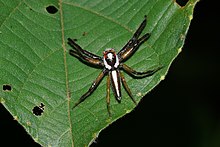Telamonia dimidiata
| Two-striped jumper | |
|---|---|

| |
| Female | |
| Scientific classification | |
| Domain: | Eukaryota |
| Kingdom: | Animalia |
| Phylum: | Arthropoda |
| Subphylum: | Chelicerata |
| Class: | Arachnida |
| Order: | Araneae |
| Infraorder: | Araneomorphae |
| Family: | Salticidae |
| Subfamily: | Salticinae |
| Genus: | Telamonia |
| Species: | T. dimidiata |
| Binomial name | |
| Telamonia dimidiata | |
| Synonyms | |

The two-striped jumper, or Telamonia dimidiata, is a jumping spider found in various Asian tropical rain forests, in foliage in wooded environments.
Description


Females can reach a body length of 9–11 mm (0.35–0.43 in), males can reach a length of 8–9 mm (0.31–0.35 in). The female is light yellowish, with a very white cephalus and red rings surrounding the narrow black rings around the eyes. Two longitudinal bright red stripes are present on the opisthosoma.[3] The male is very dark, with white markings, and red hairs around the eyes. They appear in Singapore, Indonesia, Pakistan, Iran, India, and Bhutan. T. dimidiata produces no toxin significant to humans.
Email hoax
Since 1999, the spider has been the subject of an email hoax claiming that it was a fatal spider found lurking under toilet seats in North Florida.[4] This hoax was a rehashing of an older email circulated in 1999 with similar claims, except under the name "South American Blush Spider (arachnius gluteus [sic])" - literally "butt spider". Similar email hoaxes (with details of the original changed) occurred in other parts of the world, alleging the same falsity in the recipients' countries. Lately[when?] it has also appeared on Facebook, also including a picture of the arachnid. Posts commonly report of it being found world-round, suggesting everyone must take precautions.[5] No such events appear to have occurred, and the story is considered an urban legend.[6][7][8] The false rumor has since spread to websites such as Twitter, Facebook and Tumblr in 2012. Now the same hoax is circulating on WhatsApp (2018). The hoax has also been seen on Facebook in 2019.
Footnotes
- ^ "Taxon details Telamonia dimidiata (Simon, 1899)", World Spider Catalog, Natural History Museum Bern, archived from the original on 2024-06-19, retrieved 2017-02-27
- ^ Tikader, B. K. (1974). "Studies on some jumping spiders of the genus Phidippus from India (family-Salticidae)". Proceedings of the Indian Academy of Sciences. 79 B (3): 120–126. doi:10.1007/BF03045438. S2CID 198138145.
- ^ Murphy & Murphy 2000:300
- ^ "Hoax Slayer website". October 2010. Archived from the original on 1 October 2010. Retrieved 28 September 2010.
- ^ "New poisonous spider in the United States". facebook.com. Archived from the original on 2016-11-05. Retrieved 2012-10-21.
- ^ "UCR Spiders Site: Internet Hoax". Spiders.ucr.edu. 2009-08-03. Archived from the original on 2017-07-21. Retrieved 2011-11-22.
- ^ "Spider Myths: Pulsating cactus". Washington.edu. 2010-09-01. Archived from the original on 2010-10-13. Retrieved 2011-11-22.
- ^ Snopes: Urban Legends Reference Pages: Two-Striped Telamonia Spider Archived 2024-06-19 at the Wayback Machine. Retrieved 2007-FEB-25.
References
- Murphy, Frances; Murphy, John (2000). An Introduction to the Spiders of South East Asia. Kuala Lumpur: Malaysian Nature Society. ISBN 978-9839681178.
External links
- Proszynski, Jerzy (1997). "Salticidae (Jumping Spider): Diagnostic Drawings Library". Dimidiat. The Peckham Society.
- Proszynski, Jerzy. "Salticidae (Jumping Spider)".
- Craword, Rod (Oct 23, 2015). "Myth: Baby tarantulas made cactus explode". Burke Museum.
